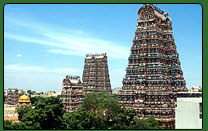
Madurai is a 2600 years old historical city surrounded by elegant natural plantations, technical institutes and textile mills situated in Tamilnadu, India.
The city is known for its rich heritage, culture and historical background in the sense that Lord Shiva himself performed sixty-four wonders called "Thiruvilaiyadals" in Madurai many centuries ago. Madurai is located on banks of river Vaigai and was the capital of Pandya kingdom.
Madurai is the busiest commercial center in south Tamilnadu. This sacred city of south India attracts thousands of pilgrims and visitors from India and abroad. Legend says, Madurai was once called forest KADAMBAVANAM. Once a merchant named Dhananjaya who was passing through the forest, saw INDRAN - the king of Gods, worshipping a SWAYAMBHULINGAM under a kadamba tree in the forest. This was reported immediately to the king KULASHEKARA PANDYAN. Kulashekara cleared the forest and built a magnificent Sri Meenakshi Sundareswarar temple around the sacred LINGAM and he built a lotus shaped city around the temple. On the naming ceremony of the city, Lord Shiva appeared magnificently to bless the city. The divine nectar (madhu) from the matted locks of Shiva fell on the blessed city. So, then the city was named "Madhurapuri". Madurai has reference in the great Indian epics - Ramayana , Kautilyas and Arthasastra.
As early as the 302BC, Megasthanes visited Madurai. Great travel-historians like Pliny (77AD) and Ptolemy (140AD) have made reference to Madurai in their travelogues. Marcopolo visited Madurai in 1293AD followed by Ibn Batuta in 1333AD. Later many people from Rome and Greece visited Madurai and established trade with the Pandya kings.
During the 10 century AD, Madurai was captured by Cholas. The Cholas ruled Madurai from 920 AD till the beginning of the 13th century. In 1223 AD Pandyas regained their kingdom and once again become prosperous. Pandian Kings patronised Tamil language in a great way. During their period, many master-pieces were created. "Silapathikaram", the great epic in Tamil was written based on the story of Kannagi who burnt Madurai as a result of the injustice caused to her husband Kovalan. In April 1311, Malik Kafur, the general of Alauddin Khilji who was then the ruler of Delhi, reached Madurai and raided and robbed the city for precious stones, jewels, and other rare treasures. This led to the subsequent raids by other Muslim Sultans. In 1323, the Pandya kingdom including Madurai became a province of the Delhi empire, under the Tughlaks.
The 1371, the Vijayanagar dynasty of Hampi captured Madurai and Madurai became part of the Vijayanagar empire. Kings of this dynasty were in habit of leaving the captured land to governors called Nayaks. This was done for the efficient management of their empire. The Nayaks paid fixed amount annually to the Vijayanagar empire. After the death of Krishna Deva Raya (King of Vijayanagar empire) in 1530 AD, the Nayaks became independent and ruled the territories under their control. Among Nayaks, Thirumalai Nayak (1623-1659) was very popular, even now he is popular among people, since, it was he who contributed to the creation of many magnificent structures in and around Madurai. The Raja Gopuram of the Meenakshi Amman Temple, The Pudu Mandapam and The Thirumalai Nayakar's Palace are living monuments to his artistic fervor.
Madurai started slipping into the hands of the British's East India Company. In 1781, British appointed their representatives to look after Madurai. George Procter was the first collector of Madurai.
Now after Indian independence, Madurai is one of the major districts of Tamilnadu State. Madurai is surrounded by several mountains. It is famous for Jasmine Flowers. Jasmine flowers are transported to various other cities of India from Madurai. Kodaikanal is the beautiful hill resort situated near Madurai. The city is surrounded by three small prominent hills which are called the Anaimalai, Pasumalai and Nagamalai named after their resemblance to an Elephant, a Cow and a Snake respectively.
Madurai, one of India's oldest cities, boasts of a history dating back to Sangam period of the pre-Christian era. It was home to the ancient Tamil Sangam (The Academy of Tamil Learning), and hosted the literary conclave that produced the first Tamil epic Silappathikaaram and other literary masterpieces. Megasthenes, the ancient Greek diplomat and envoy to India in 3rd century BC, had written in glowing terms about Madurai in Indica, his much celebrated account on India. Madurai reached its height of glory during the rule of the Cholas, and finally the Pandyas in the 13th century.
Pandyas
The Meenakshi-Sundareswarar temple, which stands today as one of India's cultural and architectural landmarks, was originally built by the Pandya King Kulasekaran. The ancient city of Madurai was then developed in a Lotus like formation with the temple at the center and streets and main thoroughfares layered one after the other in a concentric fashion. It is important to note that these streets were named after months in the Tamil calendar. For example, the first layer is named after the Tamil month of Aadi and the streets are named North, South, East, and West Aadi Streets. Next to Aadi street is Chithirai street. Legend has it that on the day the city was to be named, Lord Shiva blessed the land and its people while divine nectar showered on the city from his matted locks. The city hence came to be known as "Madhurapuri" meaning "The Land of Divine Nectar". The city has often been referred to as "Athens of the East" thanks to the beautiful architecture of all the ancient monuments and to meticulous urban planning.
Muslim Rule
In 1311 AD Madurai was invaded by Malik Kafur, the general of Alauddin Khilji who ruled the Delhi Sultanate. Subsequently, the sanctum sanctorum of the Meenakshi Temple was closed and the main deity was shifted to the Ardhamandapam. Madurai remained in control of Muslim rulers for the next fifty years. However, in 1371, the Vijayanagar rulers of Hampi raided the city and annexed it to their Kingdom.
Nayak Rule
Vijayanagar rulers appointed Governors known as Nayaks to administer this newly annexed territory.Later by 1545 the Nayaks became more autonomuus establishing the Madurai Nayak dynasty ruling upto 1740's.The temple was reopened and the Nayaks, most notably Thirumalai Nayak, contributed much to the rebuilding of the temple that had almost been destroyed during the Muslim rule. The Nayaks made lasting contributions to the city's architecture such as the Raja Gopuram of the Meenakshi Temple, and the Thirumalai Nayak Palace. After the Vijayanagar empire collapsed in 1565, the Nayak dynasty continued to rule Madurai for about two centuries.
Rani Mangammal (1689-1704) was other notable ruler who made large contributions to the cities structures.During her reign Shivaji Bhonsle, the great Maratha Ruler, invaded the south; and so did Chikka Deva Raya of Mysore and other Muslim Rulers, resulting in chaos and instability all around.Rani Mangammal,stood up against these invasions. Though her rule lasted no more than two decades, she will forever be cherished by the people of Madurai for the prudence, determination and courage she exhibited during a particularly troublesome period, with very little support from outside.The kingdom began to break up after her rule as her successors were weak rulers and invasions of Madurai recommenced.
British Rule
Madurai soon started slipping into the hands of the British East India Company. By 1801, the whole of Madurai district, which then was made up of Dindigul, Palani, Kodaikkanal, Ramanathapuram and Sivagangai was brought under the control of British East India Company. Madurai was the birthplace of American academic Vida Dutton Scudder. American missionary Henry Martyn Scudder came to Madurai in 1846.
Today, Madurai stands on the banks of the river Vaigai. The city is well known for its spiritual hill Thiruparankundram which abodes lord Subramaniya . Apart from this the ancient city is also surrounded by three small prominent hills which are called the Anaimalai, Pasumalai and Nagamalai from their supposed resemblance to an elephant, a cow and a snake respectively.





